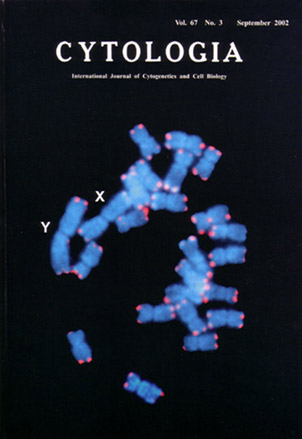| ON THE COVER |  |
|---|---|
| Vol. 67 No.3 September 2002 | |
| Technical note | |
|
|
|
| The dioecious plant, Silene latifolia, has large heteromorphic X and Y sex chromosomes that are thought to be
derived from rearrangements of autosomes. The plate shows mitotic chromosomes
from a male root meristem of S. latifolia after fluorescence in situ hybridization (FISH) with an Arabidopsis-type telomeric sequence. (CCCTAAA)n/(TTTAGGG)n, as a probe. Twin spots (red) can be observed on both ends of almost all
of the chromosomes. The telomeric sequences were amplified by PCR (Ijdo
et al. 1991),labeled with digoxigenin-1l-dUTP, and detected using a combination of anti-DIG-rhodamine and anti-sheep-Cy3. This combination of two antibodies enabled us to observe comparatively small telomeric repeats of S. latifolia. Chromosomes were counterstained blue-white with DAPI. The fluorescent images were separately fed into a chilled CCD and processed with an imaging software. Our results not only confirmed that the S. latifolia chromosomes contain telomeric sequences at their ends (Riha et al. 1998) but also provided some information to analyze ITRs in the sex chromosomes
and to investigate the evolutionary history of the sex chromosomes of S. latilolia (see Uchid, W., Matsunaga, S., Sugiyama, R., Shibata, F., Kazama, Y., Miyazawa. Y.. Hizume, M. and Kawano, S.: Chromosoma, in press, 2002). (Wakana Uchida, Sachihro Natsunaga and Shigeyuki Kawano, Department of Integrated Biosciences, Graduate School of Frontier Sciences, University of Tokyo, Bldg. FSB-601, 5-1-5 Kashiwanoha. Kashiwa, Chiba 277-8562, Japan ) |
|